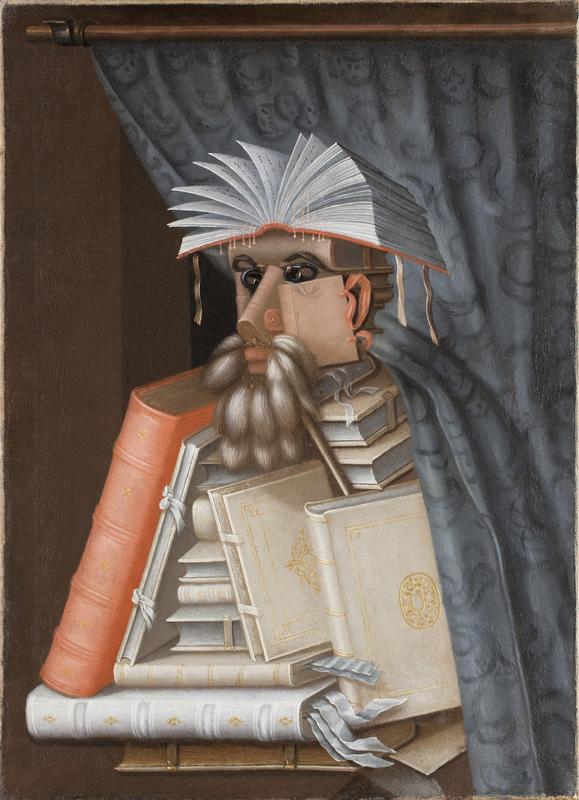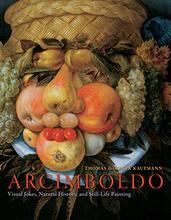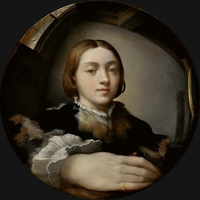More about The Librarian
- All
- Info
- Shop

Contributor
With its surrealist wit, the painting The Librarian by Giuseppe Arcimboldo blurs the line between portrait and still life and divides opinions on its creator’s intentions.
A portrait of a librarian constructed of books? Or a still life of books that resembles a librarian? Whatever you see in The Librarian, you are right. The perceived shape of a man’s body and face is, at closer look, a mere assemblage of books. But wait, what about his spectacles, his facial hair, and his fingers? Book chest keys, a duster made from furry animal tails, and bookmarks. It must have been an unexpected vision to see on canvas in the middle of the 16th century. What might have been even more surprising - and still is - is that this painting is believed to depict Wolfgang Lazius, a famous historiographer, antiquarian and physician to several Holy Roman Emperors of the Hapsburg Family.
In 1562, at the age of 36, the Italian painter Arcimboldo was appointed the official imperial court portraitist at the Habsburg court in Vienna during the reign of Ferdinand I, a position he would continue to hold during the reigns of Maximilian II, and his son, Rudolf II, at their court in Prague. In his reputable new position, which he held for more than a quarter century, his job was to portray the people of intellect and noble origins around him. However, unlike other court painters who depicted their subjects with a proper portion of pride, seriousness and glamour, Arcimboldo came to be known for his ‘composite heads’. These were portraits composed of, most famously, fruits and vegetables, but also pots and pans, and, in the case of The Librarian, books. Arcimboldo turned objects related to his subjects’ favorite activities, into mind-bending visual representations.
Wild fantasy or cynical parody? Where did his inspiration come from? Previous to being a court painter, Arcimboldo’s works adhered to rather conventional religious art practices, such as stained glass art, tapestry design and fresco paintings. So nothing unusual there. Only after he entered the world of royalty in the court did he begin painting his bizarre composite heads, for which he is still remembered today. Did the royal family know what they were in for hiring Arcimboldo? Or did they even play their own part in coming up with this eccentric idea? In any case, the family loved it - so much so that Rudolph II made Arcimboldo a Count Palatine in 1592. But was it simply for their sense of humor or does something more complex lie behind these paintings?
Scholars, historians and art critics throughout history have been torn about the interpretation of the works. More often than not they viewed them as surreal amusement or caricatures for the enjoyment of the court. Even though this might be partly true, this description is likely to be a reduction of the artworks’ true essence, and possibly a projection of the critic’s own humor on something that belies a more serious meaning. A more likely suggestion was that Arcimboldo’s works were not silly jokes but “serious jokes," as in Sigmund Freud’s definition of jokes that are not only humorous, but also raise provocative questions through displacement and surprise.
The critiques did not end there, especially for The Librarian. Some thought this painting was satirically mocking scholars and librarians, others, a celebration thereof. Or how about a “parody of greedy book collectors interested in collecting books and not reading them”? “An imperial allegory”? Or “the expression of the complicated intellectual world of the late 16th century”?
Whatever Arcimboldo’s real intentions were, his paintings are truly an enrichment for the art world, for their own sake, as well as for being an inspiration for many artists to come, such as the iconic surrealist Salvador Dali. And, thinking about it, who would say no to a portrait of themselves made up of the items they love most?
Sources
- “Arcimboldo 1526-1593: Nature and Fantasy.” National Gallery of Art. September 19, 2010 - January 09, 2011. https://www.nga.gov/content/dam/ngaweb/exhibitions/pdfs/arcimboldo_broc…
- Elhard, K.C., “Reopening the Book on Arcimboldo’s Librarian.” Libraries and Culture, Vol.40, no.2. (Spring 2005): 115-127. https://www.proquest.com/docview/222561703/fulltextPDF/588E1AA6BE8A411B….
- Fernández, G. “Giuseppe Arcimboldo.” The Artwolf. Accessed on April 07, 2022. https://theartwolf.com/arcimboldo/
- “Giuseppe Arcimboldo.” The Art Story. Accessed April 09, 2022. https://www.theartstory.org/artist/arcimboldo-giuseppe/
- Graham-Dixon, Andrew. “ITO220: The Librarian by Giuseppe Arcimboldo.” July 11, 2004. https://www.andrewgrahamdixon.com/archive/itp-220-the-librarian-by-gius…
- Kaufmann, Thomas Dacosta. Arcimboldo: Visual Jokes, Natural History and Sitll-Life Painting. Chicago & London: The University of Chicago Press, 2009.
- Shank, Ian. “The Renaissance Artist Whose Fruit-Faced Portraits Inspired the Surrealists.” Artsy. September 08, 2017. https://www.artsy.net/article/artsy-editorial-renaissance-artist-fruit-….
- “The Librarian (Painting).” Wikipedia. Last edited on June 27, 2021. https://en.wikipedia.org/wiki/The_Librarian_(painting)
- Tucker, Abigail. “Arcimboldo’s Feast for the Eyes.” January 2011. https://www.smithsonianmag.com/arts-culture/arcimboldos-feast-for-the-e….
Featured Content
Here is what Wikipedia says about The Librarian (Arcimboldo)
The Librarian is a painting in oils on canvas by the Italian artist Giuseppe Arcimboldo in the collection of Skokloster Castle in Sweden. It is thought to be a portrait of Wolfgang Lazius, a humanist and historian who served Holy Roman Emperors of the House of Habsburg.
Arcimboldo became official portraitist to Emperor Ferdinand I in 1562 and later to Maximilian II and Rudolf II. The Librarian is one of a series of paintings by Arcimboldo of members of Maximilian's entourage. Skokloster Castle dates the painting to 1562, though the painting is more often dated circa 1566.
Arcimboldo created a number of portraits of people by painting an assemblage of objects such as fruits and vegetables, flowers, or in this case, books; the objects typically had some connection to the person's life or depiction. Benno Geiger called it a "triumph of abstract art in the 16th century". In 1957, art historian Sven Alfons was the first to conclude that this was specifically a portrait of Lazius. The work has been interpreted as both a celebration and a satirical mocking of librarians and scholarship. K. C. Elhard suggests an opposing view that it may be specifically a parody of "materialistic book collectors more interested in acquiring books than in reading them." Elhard notes that various references to the librarian's trade are missing from the image, such as any kind of classification marks. He also argues that the painting focuses on the materialistic qualities of the books and not the subject matter, pointing to collectors, and not necessarily librarians or intellectuals.
Elhard notes that The Librarian has become "a fixture in the visual history of the library profession". However, the original title, if any, is unknown, and its current title first appears (in Swedish as "Bibliotekarien") in an early 20th-century inventory.
The Librarian is one of two works by Arcimboldo in the collection of Skokloster Castle (the other being Vertumnus). The painting was brought to Sweden following the looting of Prague Castle by the Swedish army during the 1648 Battle of Prague and was owned by General Hans Christoff von Königsmarck.
There are three other extant versions of the painting whose attributions are uncertain. A scientific study published in 2011 concluded that The Librarian was a later copy of Arcimboldo's original painting, whose whereabouts are unknown.
Check out the full Wikipedia article about The Librarian (Arcimboldo)
















